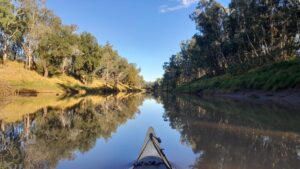We now live in an era when major expeditions set up elaborate websites, post daily on social media, and deck gear and garments with as many sponsor labels as an F1 driver. Even in the past, some adventures have always been giant productions. But not all. Once in a while, someone just went off for the hell of it and did something amazing. They never tried to make it into a big deal or cobble a living from it. They just got on with their lives. But those who remembered the boldness and outrageousness of what they achieved never forgot them.

Ed Gillet doing a test run before setting off for Hawaii.
That was the case with Ed Gillet (not the same person as Ned Gillette, a much better-known adventurer of the same era). In the 1980s, when the San Diego-based Ed Gillet was in his thirties, he did several mega-distance kayak expeditions. He spent a year paddling 8,000km along the Pacific coast of South America, but coastal kayaking was not committing enough for him. So in June 1987, the 36-year-old Gillet set out to kayak alone from Monterey Bay, California to Hawaii.

Gillet starts the journey. Photo: Ed Gillet
His journey is legendary, for good reason: No one before or since has kayaked the 4,000km from the North American mainland across the Pacific to Hawaii. Two parties who tried in recent years gave up after a single day. Even this year, Angela Madsen perished while attempting a similar route in her large, custom-built rowboat, loaded with modern technology. Gillet’s kayak was an off-the-shelf, 20-foot Tofino double kayak. Satphones did not exist, and even GPS devices were only available to the military. Beyond an emergency SOS transmitter and a radio in case he came within earshot of another vessel, Gillet was totally on his own.
Pontoons stabilized the boat and allowed him to sleep
Gillet stuffed the boat with 275kg of food and equipment for an estimated 40-day crossing. Under the weight, the kayak rode so low in the water that the cockpit was almost awash. To sleep, he had to spend half an hour every night inflating two pontoons to stabilize his craft. Then he deployed his sea anchor, draped a tarp over the open cockpit, and tried to sleep. The tarp did not keep the water out very well.
In that first week, he battled the California current, drifted off course, and almost gave up when his rudder broke. Eventually, he improvised a solution and found the mettle in himself to continue. He knew that this would be his only opportunity to attempt such an outlandish crossing.
He took sextant readings three times a day, morning and night for longitude and noon for latitude, so he knew where he was at all times. He had a kite that he deployed to tow him in a tailwind. Once, he made as much as 130km in a day. But 1987 was an El Niño year, with calmer-than-normal trade winds, so he could only use the kite one-third of the time.

Gillet on day 45.
As time went on, a lot went wrong.
He lost crucial gear overboard in rough seas. Seawater splashed him constantly, creating ever-worsening open sores that spread over his entire body. He had to take painkillers so that he could hold the paddle and sedatives to sleep through the pain. But Halcyon, the particular sleeping pill he used, had occasional serious side effects, including anxiety, panic attacks, and depression. As bad luck would have it, Gillet was sensitive to the drug. He knew he was suffering severe psychological symptoms but he had no idea that they were side effects of the sleeping pills. Regardless, he soldiered on.
Completely out of food, he ate toothpaste
He fell far behind and was running out of food. Even rationing wasn’t enough. By day 60, he had nothing left. For comfort, he ate bits of toothpaste. By the time he reached Maui on day 64, he was on the brink of starvation. He later admitted that it was “the very real danger of starving” that scared him the most.
Since he was over three weeks behind schedule, his family and the authorities were sure that he had perished. So when he reached Maui, he was completely alone: No one was there to greet him. And so an almost-starved, sleep-deprived, anxiety-ridden, world-record-breaking Gillet stepped out onto an empty beach, where his legs gave out beneath him.
There was a brief flurry of media interest afterward, including an appearance on The Tonight Show Starring Johnny Carson, below. But Gillet soon settled down, set up a kayak business for a while, and later became a high school English teacher. For years, he rarely spoke of his epic journey.
Then in 2013, an editor and writer with Canoe & Kayak magazine, Dave Shivley, convinced Gillet to let him tell his story. Thirty years after his achievement, The Pacific Alone was published.
In it, Shivley marveled at how “hit or miss” the expedition was. He wrote: “Had Gillet missed his mark, he would have remained alone in a kayak somewhere in the middle of the world’s largest ocean: a prospect that almost became a reality.”
Now 69, Gillet seems to have rediscovered the ocean and is currently sailing the world in a 14m sailboat. “Crossing oceans…is what I’m really good at,” he admitted in a recent interview. “I kind of flounder on land.”






